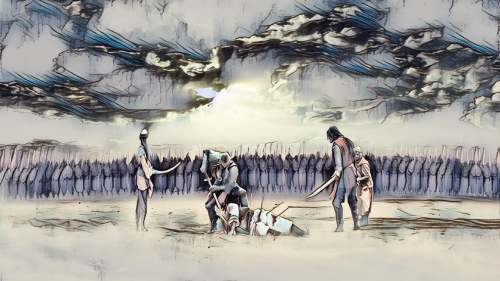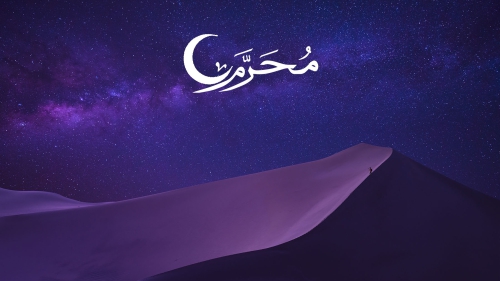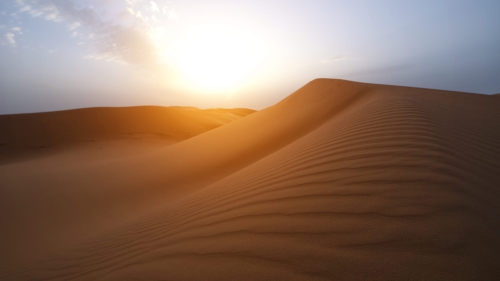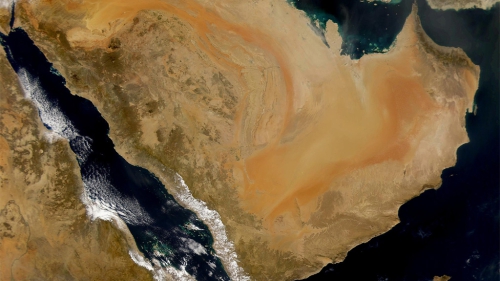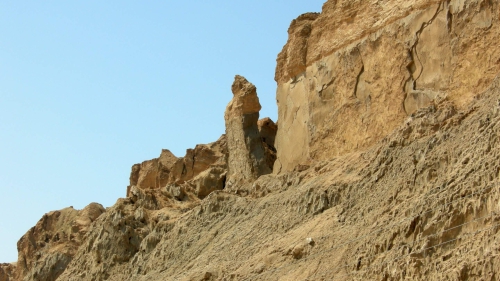Religious Coexistence and Bilingualism

Kathir bin Qays said: “I was sitting with Abu al-Darda’ in the mosque of Damascus. A man came to him and said: Abu al-Darda’, I have come to you from the town of the Messenger of Allah (pbuh) for a tradition that I have heard you relate from the Messenger of Allah. I have come for no other purpose. He (Abu al-Darda’) said: I heard the Messenger of Allah (pbuh) say: If anyone travels on a road in search of knowledge, Allah will cause him to travel on one of the roads of Paradise. The angels will lower their wings in their great pleasure with one who seeks knowledge, the inhabitants of the heavens and the earth and the fish in the deep waters will ask forgiveness for the learned man. The superiority of the learned man over the devout is like that of the moon, on the night when it is full, over the rest of the stars. The learned are the heirs of the Prophets, and the Prophets leave neither dinar nor dirham, leaving only knowledge, and he who takes it takes an abundant portion” 1Sunan Abi Dawud, Book 26, Hadith No. 1.
This hadith entails numerous important lessons. Two concerning religious tolerance and coexistence, and the importance of bilingualism, will be addressed here.
Religious tolerance and coexistence
When the man came to see Abu al-Darda’ – as per the above hadith - the latter was in the mosque of Damascus. The place was what later came to be known as the Umayyad Mosque or the Great Mosque of Damascus.
Once Muslims “opened” Damascus to Islam (fath), they had no place to worship. They needed something urgently and the time was not right to embark on building activities. At the same time, the city was full of churches. But as many local Christian residents decided to leave, and many others later decided to convert to Islam, some of those churches were slowly losing their functionality.
Nonetheless, as it was the policy of Muslim liberating armies wherever they went, the people of Damascus were guaranteed security for their lives, their property and their churches, and no Muslim was to be quartered in their houses. So long as they paid the jizyah (a poll tax on free non-Muslims under Muslim rule) and cooperated in matters of common interest, they were promised to live undisturbed and nothing but good was to befall them.
It was decided under the circumstances that a section of one of the city’s churches be designated as a small prayer house (musalla). The church was dedicated to John the Baptist (Prophet Yahya). It contained the burial place of his head, over which a chamber had been erected.
The place was steeped in history. Firstly, it served as a pagan temple of the Arameans, then as a pagan temple of the Romans, and after Christianity had become the official religion of the Roman Empire, it was converted into a church.
After the arrival of Muslims, the building was shared by both Muslims and Christians. It retained its status as a church, but now, partially, it became a makeshift mosque as well. Upon entering the church, the Christians would turn to the left (the West) to go to their section of the church, and the Muslims would turn to the right (the East) to go to their own section of the church. They all shared the same main entrance. For the mosque section, no structural alteration of the building was undertaken.
Later however when the number of Christians in the city of Damascus dramatically decreased and the number of Muslims increased, it was agreed that the church in question be appropriated by Muslims and then converted into a full-fledged mosque. This was done by the sixth Umayyad Caliph al-Walid bin ‘Abd al-Malik who ruled from 705 to 715 CE.
Subsequent to the conversion, the mosque retained John the Baptist’s tomb as part of its interior. There are still several structural and decorative elements that testify to the mosque’s long and rich multi-religious history. There was nothing inappropriate in keeping them.
Abu al-Darda’, originally from Madinah, migrated to Syria and served as a governor there during the caliphate of ‘Uthman bin ‘Affan, the third rightly-guided caliph. He died in Damascus before the death (assassination) of Caliph ‘Uthman.
This means that Abu al-Darda’ was teaching in the improvised mosque that was part of the church. Not a soul saw anything wrong, or inhibiting, in this, so much so that this initial status of the mosque was hardly ever drawn attention to. Extensive reports are given only in the context of the caliphate of al-Walid bin ‘Abd al-Malik, albeit not as something problematic, but as a mere piece of history.
Similarly, this demonstrates that, historically, Muslims were paragons of religious tolerance and coexistence. That was integral to their successful propagation and spread of Islam. Commencing with the time of Prophet Muhammad (pbuh) himself, Muslims were also the originators of the notion of interreligious dialogue, with mosques often functioning as the venues of the proceedings.
Indeed, history is replete with evidences that invalidate the baseless claims to the effect that Islam is a religion of violence and that it was spread by the sword, and that Prophet Muhammad (pbuh) and his followers were vicious and violent men who sowed barbarity.
The importance of bilingualism
When Islam and Muslims came to Syria, Arabic was not the lingua franca of the region, except among existing Arab tribes. There were several other languages that could lay claim to the honour. However, following the advent of Islam and as part of the natural Arabization (migration of Arabs to the territory) and Islamization processes, the Arabic language was rapidly gaining currency.
The teaching efforts of Abu al-Darda’ – who had migrated from Madinah – connoted an epitome of those processes. The whole scene depicted in the hadith quoted at the beginning, additionally, gave an inkling of the vibrant – perhaps dramatic - diffusion of Islamic culture and civilization on the global stage.
Arabic was the official language of Islam, Islamic culture and civilization. As expected, every Muslim had a special affinity with it and wanted to learn it as much as possible. Doing so provided a sense of belonging within the universe of Islam and its civilizational trajectory. It provided a spiritual identity, which transcended and overshadowed all other identities.
But Islamic culture and civilization are not exclusive or discriminatory in any way. On the contrary, they are inclusive and egalitarian. Everybody has a place and rights in them, and everybody who can is welcome to enrich them. What is more, people are encouraged to remain faithful to the wholesome components of their diverse socio-cultural affiliations. Those are seen as enriching and energizing, rendering the idea of unity-in-diversity as one of the fundamental and most dynamic principles of Islam as a complete way of life.
If Arabic was the official language, formally and institutionally promoted by authorities – Abu al-Darda being a governor and educator represented the trend – such on no account implied that other languages were suppressed. The provision in the treaty by the Muslim commanders that “nothing but good was to befall them (the citizens of Damascus)” - in addition to the assurances of total protection and wellbeing - was the guardian.
This approach made most especially non-Arab Muslims bilingual. The tendency was an inestimable national treasure. It facilitated the establishment and preservation of religious orthodoxy, of a unified learning culture, of religious and national unity prospects, and of a religious and ummatic (collective as well as democratic) identity. It enhanced people’s communication and broadmindedness, making them feel at home in all situations. It made Islam much more easily understood, practiced and propagated. It also encouraged respect for the otherness of others and aided religious and ethnic pluralism.
It was not uncommon that in times of crises, when the Muslim community en bloc and its civilizational projections stood at a crossroads, Arabic as the lingua franca of institutions and of a great many sectors of Muslim societies proved as pivotal as people’s belonging to Islam. The language – together with Islam itself – was a warrantor of survival followed by renewal.
Accordingly, the centre of gravity of Islamic traditional educational systems always consisted of studies of the Qur’an and Arabic. The former represented the threshold, as well as the fountainhead, of the pure religious sciences, which ensured religious awareness and identity, while the latter stood for an instrument of all sciences and of the Islamic cultural and civilizational identity.
Only with the Qur’an and Arabic on-board could the dream of Islamic ummah (Islamic supranational community or nation) be realized. Only with the function of those two could Islamic culture and civilization genuinely flourish.
As an indication of this ethos, following the first two or three generations of Islam, most of the Muslim scholars were non-Arabs. Nevertheless, most of them wrote in Arabic, which they had perfected. Apart from many religious and intellectual sciences in which they served as front-runners, non-Arabs even founded the Arabic grammar. Ibn Khaldun explained how that came about: “All of them were of non-Arab (Persian) descent. They were brought up in the Arabic language and acquired the knowledge of it through their upbringing and through contact with Arabs. They invented the rules of (grammar) and made (grammar) into a discipline (in its own right) for later (generations to use).”
No surprise, therefore, that no sooner had the roles of the Qur’an and Arabic language been compromised, than Islamic culture and civilization started declining irreversibly. Nor is it coincidental that such decline reached a nadir when the winds of nationalism – and other small localized programs and visions - were sweeping across the Muslim world to the detriment of Islamic concepts of ummah, brotherhood and unity, and when the role of Arabic was either distorted beyond recognition or was abandoned altogether.
One of the most painful outcomes of this partly deliberately concocted and partly self-inflicted tragedy is that nowadays most Muslims can hardly read, let alone understand, Arabic and, by extension, the Qur’an. Yet a great many Arabs were made prefer local dialects and some utterly distorted versions of Arabic with the aim of becoming strangers to the pure Arabic language and to the Qur’an (i.e. to the pristine message of Islam).
Certainly, this is not a milieu where the potential of reviving the glories of Islamic culture and civilization is feasible. It instead is a nightmare that must stop before turning a new leaf. The only way forward, it stands to reason, is return to the original teachings of Islam and its Prophet Muhammad (pbuh), but via the Qur’an as the goal (constitution) and Arabic as a mechanism. The only way forward, furthermore, is that Muslims become authentically good and be at least bilingual – even trilingual in today’s globalized world - and function as such, in the best way possible.
This is the central meaning of the sanctity of knowledge and knowledge seeking in today’s context. Muslims are ordained to lead the world, and if nothing else, a statement of intent is to be made.
Footnotes
Topics: Arabic, Church, Dawah (Outreach), Diversity, Freedom Of Religion, History, Islamic Culture And Civilization, Language, Pluralism, Ummah (Community) Values: Education, Freedom, Tolerance
Views: 1671
Related Suggestions







